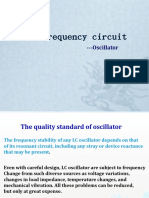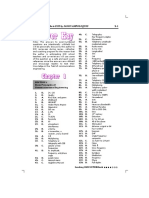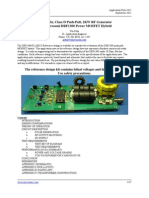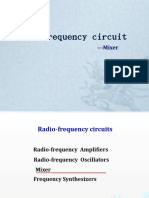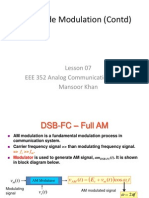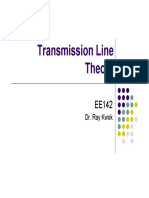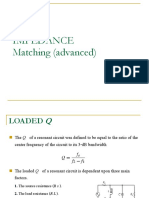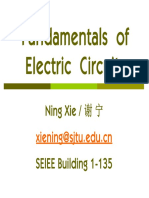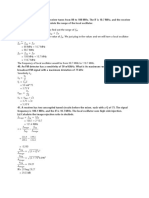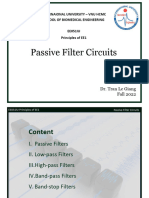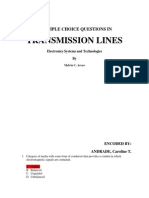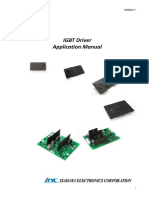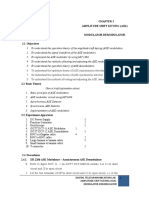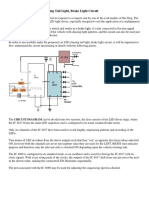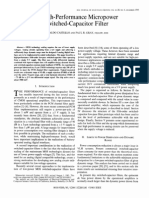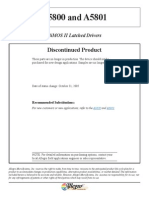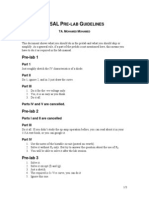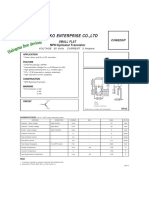RF Oscillators
Engr. Edelito A. Handig
�Introduction
An oscillator is a circuit capable of continuously generating a repetitive waveform of a desired frequency. The waveform can be sinusoidal or rectangular. It can be self-sustaining or free running. It can be triggered or one-shot.
�Oscillator: Block diagram
Barkhausen Criterion
�LC Tank Circuit
�Self-sustaining Oscillator
Four requirements for a self sustaining oscillator: 1. DC power source 2. Frequency determining components 3. Amplification 4. Positive feedback
�Sample problem:
Assume that the feedback fraction is 0.01. Calculate the required value of amplification in order to sustain oscillations. B = 0.01; AvB = 1 (Barkhausen Criterion) Av = 100
�LC Oscillators: Hartley
�LC Oscillators: Hartley
Assume that it is desired to design an oscillator with 4 MHz output frequency. If the C3 is adjusted to 300 pF and the desired feedback fraction is 1/20, calculate the ff: a. L1 and L2 b. Av to sustain oscillation. Answer: L1 = 5.029 H; L2 = 0.251 H; Av = 20
�LC Oscillators: Hartley
In a Hartley oscillator, C3=100 pF, L1=1mH, and L2=10 H. Calculate the ff: a. Frequency of oscillation b. Feedback fraction and Av to sustain oscillations. Answer: Freq = 500.79 KHz; B = 0.01 Av = 100
�LC Oscillators: Colpitts
�LC Oscillators: Colpitts
Determine the feedback fraction, Av, and operating frequency for the Colpitts oscillator with L1=1H, C1=10pF, and C2=100pF. Answer: B=0.1 ; Av=10; Freq=52.8MHz
�LC Oscillators: Colpitts
Assumed that it is desired to design a Colpitts oscillator so that its output frequency is 4 MHz. If L1 = 50 H and the feedback fraction is 1/20. Calculate the ff: a. C1 and C2 b. Av to sustain oscillations. Answer: C1 = 33.24 pF; C2 = 666.06 pF Av = 20
�LC Oscillators: Clapp
�LC Oscillators: Clapp
In a Clapp oscillator, L1 = 1 H, C1=100pF, C2=1000 pF, and C3=10pF. Calculate the ff: a. Frequency of Oscillation. b. Feedback fraction and Av to sustain oscillations. Answer: F = 53.02 MHz; B = 0.1; Av = 10
�Seatwork
In a Clapp oscillator, L1 = 5 H, C1=75 pF, C2=500 pF, and C3=30pF. Calculate the ff: a. Frequency of Oscillation. b. Feedback fraction and Av to sustain oscillations. c. Suppose the value of C2 doubles, by what percentage does this change the operating frequency?
�RC Oscillator: Phase Shift Oscillator
�RC Oscillator: Phase Shift Oscillator
�RC Oscillator: Wien Bridge Oscillator
�Crystal Oscillator
A crystal oscillator is an electronic oscillator circuit that uses the mechanical resonance of a vibrating crystal of piezoelectric material to create an electrical signal with a very precise frequency.
�Crystal Oscillator
A radio transmitter has to operate at temperature from 5C to 35C. If its signal is derived from a crystal oscillator with a temperature coefficient of 1ppm/C and it transmits at exactly 146MHz at 20C, find the transmitting frequency at the two extremes of the operating temperature range. fmax = 146.00219 MHz fmin = 145.99635 MHz
�Crystal Oscillator
A crystal oscillator applied to Hartley Oscillator.
�Crystal Oscillator
A crystal oscillator applied to Colpitts Oscillator.
�Crystal Oscillator
Variation of crystal oscillator applied to Colpitts Oscillator.
�Crystal Oscillator: Pierce Oscillator
If B = 1/25 and the equivalent capacitance of C1 and C2 is 250 pF, find the values of C1 and C2.
�Voltage controlled Oscillator: VCO
It is a free running oscillator whose frequency of operation is controlled by an external dc bias voltage. The natural frequency is equal to the output frequency with a dc input of zero volt. K = f / V Hz/Volt (Conversion gain or transfer function)



